Charger LiitoKala Engineer Lii-500


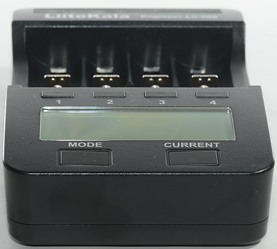
LiitoKala continues to improve each time they make new charger models, this time it is a 4 channel charger with charge and discharge functions (All their Engineer models have discharge).

It arrived in a nondescript cardboard box, that could directly be used for shipping.

The box contained the charger, power adapter, car power adapter and a manual.
The supplied power adapter is a universal voltage (100-240VAC 50/60Hz) with 12V 2A output.

The charger has a DC power input, for the mains adapter and the car adapter.
There is also a 1A usb output.

The user interface is 6 buttons and a display. The four top buttons is used to select a specific slot, when none of them has been pressed MODE and CURRENT works on all slots simultaneously.
The two bottom buttons is used to select mode (Charge, fast discharger, normal discharge) and current (300, 500, 700, 1000mA). The current is charge current, discharge current will be either 250mA (300/500 selected) or 500mA (700/1000 selected).

During power on the charger will turn all segments in the display on.
As can be seen the display will only show data for one channel at a time, but you get all the data at once.


Here are two examples of the display during charge.


The slots uses the classical slider construction and it works fine.
The slots can work from 32 mm to 71.3mm. This means that it will handle just about all protected 18650 and 26650 cells.



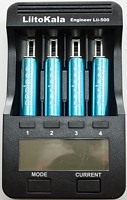








The charger can handle 71.3 mm long batteries including flat top cells.
Measurements
- Power consumption when idle is 0.94 watt, it drops to 0.69 watt when the display is off.
- When not powered the charger will drain LiIon batteries with 2mA
- When not powered the charger will drain NiMH batteries with 0.4mA
- Below 0.3 volt charger will not recognize any batteries, but still charge with 3mA.
- Below 1.6 volt batteries are assumed to be NiMH.
- Above 2.2 volt batteries are assumed to be LiIon.
- Charger will not restart if battery voltage drops.
- Charge will restart charging after power loss, or battery insertion.
- Voltmeter do not update when charging is finished.
- Voltmeter has a minimum reading around 0.6 volt
- Voltmeter is within 0.02 volt.
- Display light will turn off after 30 seconds.
Charge LiIon
%20%231.png)
This is a good CC/CV charge curve with a termination just below 100mA.
Display shows 2945mAh in 3:33 hours
%20%232.png)
Display shows 2914mAh in 3:31 hours
%20%233.png)
Display shows 2925mAh in 3:27 hours
%20%234.png)
The other 3 channels looks the same.
Display shows 2942mAh in 3:42 hours
%20%231.png)
This battery takes about the same time to charge at 1A, because the CV phase is a bit longer.
Display shows 2554mAh in 3:29 hours
%20%231.png)
Display shows 3194mAh in 3:44 hours
%20%231.png)
This cell is a bit older and has a very long CV phase, making it slower to charge.
Display shows 2202mAh in 4:12 hours
%20%231.png)
The charging curve is also good at 300mA, but I would have liked a lower termination current.
Display shows 2848mAh in 9:58 hours
%20%231.png)
Display shows 2950mAh in 4:48 hours
%20%231.png)
Display shows 779mAh in 1:55 hours
%20%231.png)
Display shows 658mAh in 1:34 hours
.png)
With 4 cells in the charger and full charge current it get a bit warm.
Display shows 2975mAh, 2975mAh, 3015mAh, 2910mAh in 3:35, 3:23, 3:23, 3:15 hours
.png)
The charger needs about 1.8A from the power supply, the supplied 2A supply fits very nicely.

M1: 43,1°C, M2: 46,0°C, M3: 46,5°C, M4: 44,4°C, M5: 51,5°C, M6: 50,4°C, M7: 39,2°C, HS1: 57,1°C

The charger is slow to start, because it waits for user input. There is no pwm in the charger current at any setting.
Charge NiMH
%20%231.png)
The termination look like a voltage termination and without filling the cell completely.
Generally it looks like the capacity display is a bit high for NiMH cells.
Display shows 1941mAh in 1:56 hours
%20%232.png)
Display shows 1981mAh in 1:59 hours
%20%233.png)
Display shows 1975mAh in 1:58 hours
%20%234.png)
Display shows 2007mAh in 2:00 hours
%20%231.png)
Display shows 2574mAh in 2:34 hours
%20%231.png)
Display shows 2783mAh in 2:47 hours
%20%231.png)
The advantage with voltage termination is that it also works at low charge currents.
Display shows 1951mAh in 6:36 hours
%20%231.png)
Display shows 2008mAh in 2:53 hours
%20%231.png)
Display shows 714mAh in 1:25 hours
%20%231.png)
Voltage termination is fairly fast at detecting a full cell.
Display shows 58mAh in 0:03 hours
%20%231.png)
At low charge current the termination is a slow.
Display shows 103mAh in 0:20 hours
.png)
Four cells in a compact charger warms the cells up.
Display shows 2056mAh, 2081mAh, 2090mAh, 2103mAh
.png)
For charging NiMH the charger only need 1A.

M1: 44,5°C, M2: 45,7°C, M3: 45,3°C, M4: 43,1°C, M5: 50,0°C, M6: 47,9°C, HS1: 61,1°C
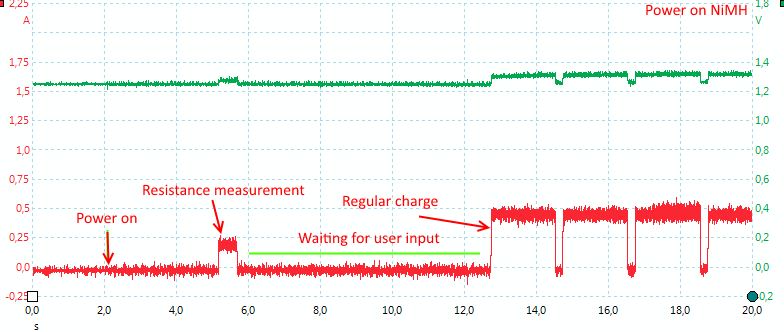
Fast test LiIon (Discharge & charge)
This test measures the charged capacity. It might be a fast test, but it takes about 10 hours!
The possible discharge currents are 500mA and 250mA, they are selected depending on charge current:
1000mA and 700mA charge current will select 500mA discharge current.
500mA and 300mA charge current will select 250mA discharge current.
%20%231.png)
The charger discharges the cell to a bit below 2.9 volt and then charges it while measuring capacity. For LiIon this works fairly well.
Display shows 3058mAh in 3:40 hours, remember that the time shown is only the charge time, not the total time.
%20%232.png)
Display shows 3040mAh in 3:36 hours
%20%233.png)
Display shows 3038mAh in 3:39 hours
%20%234.png)
Display shows 3046mAh in 3:41 hours
%20%231.png)
With 300mA selected as charge current the discharge current is 250mA.
Display shows 2974mAh in 10:22 hours
%20%231.png)
Display shows 3006mAh in 6:33 hours
.png)
Discharging 4 batteries at the same time will heat the charger.
Display shows 3052mAh, 3082mAh, 3130mAh, 3078mAh

M1: 46,9°C, M2: 49,2°C, M3: 49,1°C, M4: 47,4°C, M5: 51,9°C, M6: 50,7°C, M7: 47,2°C, HS1: 60,4°C
Lot of heat while discharging, but within discharge ratings for LiIon batteries, a cool down period before charging would have been nice.
To avoid the high temperature use the lower discharge current.

Discharge is with constant current, but it is done with a switching regulator without smoothing it. The frequency is about 60kHz. This is better than the pulsing current on many analyzing chargers.
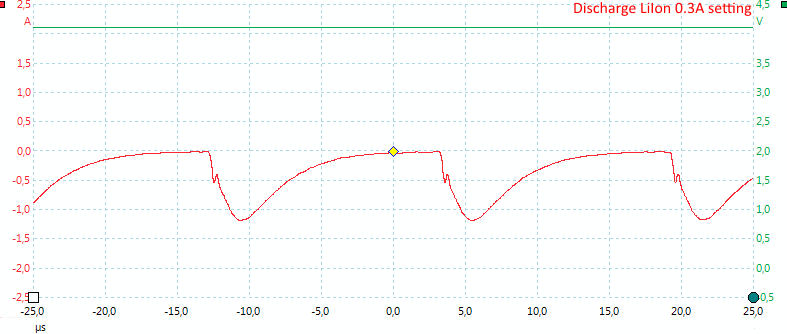
Same with the low current discharge.
Fast test NiMH (Discharge & charge)
This test measures the charged capacity. It might be a fast test, but it takes about 6 hours!
The possible discharge currents are 500mA and 250mA, they are selected depending on charge current:
1000mA and 700mA charge current will select 500mA discharge current.
500mA and 300mA charge current will select 250mA discharge current.
%20%231.png)
The battery is discharged to about 1.0 volt
Display shows 2041mAh in 2:02 hours, remember that the time shown is only the charge time, not the total time.
%20%232.png)
Display shows 2035mAh in 2:02 hours
%20%233.png)
Display shows 2037mAh in 2:02 hours
%20%234.png)
Display shows 2052mAh in 2:03 hours
%20%231.png)
With 300mA selected as charge current the discharge current is 250mA.
Display shows 1962mAh in 6:38 hours
.png)
The temperature do increase while discharging NiMH, but the power is only about 1/3 of LiIon and the heat is much less.
Display shows 2045mAh, 2108mAh, 2094mAh, 2141mAh
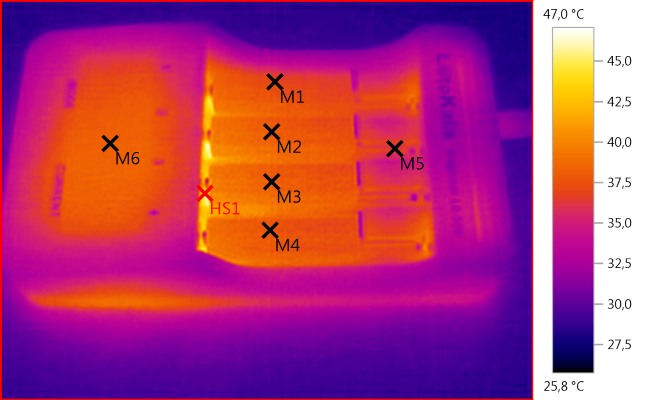
M1: 37,2°C, M2: 38,1°C, M3: 38,6°C, M4: 37,6°C, M5: 36,4°C, M6: 38,2°C, HS1: 47,0°C

Discharge is with constant current, but it is done with a switching regulator without smoothing it. The frequency is about 60kHz.
Nor test (Charge, discharge & charge)
I am not going to include many curves here, because it is a combination of the above.
When doing a normal test the discharge capacity is measured. Remember the discharge current is not the selected current, but either 250mA or 500mA.
%20%231.png)
Display shows 2955mAh in 6:10 hours, time shown is the discharge time not the total time.
%20%231.png)
This time the capacity of the NiMH cell is lower, my guess is the charger will add some percent in the charge and fast tests, because the manufacturer knows it will terminate early.
Display shows 1796mAh in 3:11 hours
Internal resistance
The charger will always show the internal resistance of batteries.
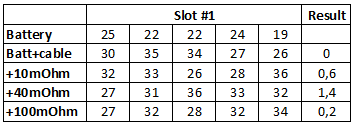
The above chart is for a LiIon cell. First line in same cell 5 times in the same slot.
The +XmOhm are supposed to show X in the result column, this does not really work.

NiMH does not look better.
The display shows higher values with higher resistance, but there is no relation to ohms.
USB output
- When not powered the charger will drain LiIon batteries with 2mA (No USB symbol on display)
- When display is on the charger will drain LiIon batteries with 26mA (Total for all loaded batteries)
- When display is off, but usb output is on the charger will drain LiIon batteries with 13mA (Total for all loaded batteries)
- MODE button will turn display on
- Usb output is coded as Apple 1A
- When power is connected, usb output is forced off.
- When the load drops below 70mA the output will turn off in 20 seconds.
%20%231%20load%20sweep.png)
The usb output can deliver about 1.2A before it starts to drop, at 1,6A it turns off. This looks reasonable.
%20load%20sweep.png)
With for batteries in the charger the output voltage is stable up to 1.4A and still maintains the 1.6A turn off.
%20%231.png)
With one 18350 3100mAh cell there is 0.5A power for a bit above 2 hours. The Turn off voltage is a bit high with about 3.3 volt.
%20%231.png)
With a 1A load the runtime is down to 40 minutes, this is not very good.
.png)
With 4 cells in the charger the output is much better, here it can maintain output for 5 hours.
Current and voltage shown are only for one cell, this makes the efficiency invalid.

There is 11mV rms and 160mVpp noise. This is very good values.

There is 15mV rms and 160mVpp noise. Even with a 1A load the noise is low (At least with a fresh battery).
Testing the EU mains transformer with 2500 volt and 5000 volt between mains and low volt side, did not show any safety problems.
Conclusion
I like the user interface, put a couple of batteries in and select mode/current with the respective buttons. As long as the number keys are not touched the selection is for all slots (Showing all slot numbers would have been nice).
The charger is very good at charging LiIon, but stops a bit early on NiMH.
The fast test works fine on LiIon, but with NiMH it shows too much capacity (the full test looks more correct).
As usual I am not impressed with the resistance function.
The usb output has very low noise, but need multiple cells to work well with 1A load.
The final result must be that it is a good charger with a useful analyze function.
Notes
Here is an explanation on how I did the above charge curves: How do I test a charger
Read more about how I test USB power supplies/charger
























%20%231.png)
%20%232.png)
%20%233.png)
%20%234.png)
%20%231.png)
%20%231.png)
%20%231.png)
%20%231.png)
%20%231.png)
%20%231.png)
%20%231.png)
.png)
.png)


%20%231.png)
%20%232.png)
%20%233.png)
%20%234.png)
%20%231.png)
%20%231.png)
%20%231.png)
%20%231.png)
%20%231.png)
%20%231.png)
%20%231.png)
.png)
.png)


%20%231.png)
%20%232.png)
%20%233.png)
%20%234.png)
%20%231.png)
%20%231.png)
.png)



%20%231.png)
%20%232.png)
%20%233.png)
%20%234.png)
%20%231.png)
.png)


%20%231.png)
%20%231.png)


%20%231%20load%20sweep.png)
%20load%20sweep.png)
%20%231.png)
%20%231.png)
.png)

